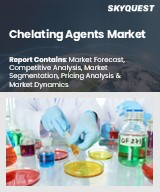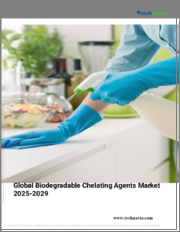
|
시장보고서
상품코드
1535738
천연 킬레이트제 시장 규모 : 제품, 유래, 용도별, 예측(2024-2032년)Natural Chelating Agents Market Size - By Product (Sodium Gluconate, Sodium Iminodisuccinate, Ethylene Diamine Disuccinate, Glutamic Acid Diacetate, Iminodisuccinic Acid, Methylglycine Diacetic Acid), Source, Application & Forecast, 2024 - 2032 |
||||||
천연 킬레이트제 시장 규모는 산업 용도의 급성장 및 지속적 기술 혁신과 연구에 의해 2024-2032년 CAGR 6.9%를 기록할 것으로 보이고 있습니다.
최근 수년간 과학자들은 천연 킬레이트제의 효과와 환경 적합성을 높이기 위해 새로운 제형을 개발하고 있습니다.
또한 치료의 발전으로 인해 이러한 약물의 금속 결합 능력이 향상되어 농업, 수처리 및 의약품의 다양한 공정을 촉진할 수 있게 되었습니다. 환경 문제를 해결하고 산업 공정을 최적화하기 위한 사용량 증가도 제품 수요에 유리하게 작용할 것으로 보입니다. 예를 들어 2023년 10월 Nouryon은 다양한 산업 공정 및 용도의 효율성을 높이기 위해 GLDA 기반 킬레이트제인 Dissolvine(R) GL Premium과 함께 고급 계면활성제이자 다기능 하이드로로프인 Berol(R) Nexxt의 출시를 발표하였습니다. 발표하였습니다.
시장은 제품, 원산지, 용도, 지역별로 구분됩니다.
제품별로 보면 천연 킬레이트제 시장에서 나트륨이미노디설페이트 부문은 효과적인 금속 결합 특성과 환경 적합성으로 인해 2024-2032년 높은 CAGR을 나타낼 것으로 예상됩니다. 농업, 수처리, 세정제 등 다양한 분야에서의 응용이 기술 혁신에 의해 강화되고 있습니다. 기존 킬레이트제에 비해 금속 이온 차단 성능을 향상시키고 환경에 미치는 영향을 줄이기 위한 급속한 개발은 이 분야의 성장을 가속할 것으로 보입니다.
공급원별로는 친환경 소재에 대한 소비자 수요 증가에 힘입어 식물 부문의 천연 킬레이트제 산업 가치는 2024-2032년 증가할 것으로 예상됩니다. 가공 기술의 혁신으로 식물 유래 킬레이트제의 수율과 성능이 향상되어 합성 대안에 대한 실행 가능한 대안이 되고 있습니다. 그 결과, 지속가능한 특성과 금속 이온을 관리하고 환경에 미치는 영향을 줄이는 효과로 인해 다양한 분야에서 천연 킬레이트제의 채택이 증가하고 있습니다.
지역별로 보면 북미의 천연 킬레이트제 시장 규모는 퍼스널케어 제품의 발전에 힘입어 2032년까지 강력한 성장세를 보일 것으로 예측됩니다. 이 지역의 기업은 제품의 안정성, 향미 유지 및 식품의 안전성을 높이기 위해 킬레이트제를 제형에 통합하고 있습니다. 또한 퍼스널케어 제품의 사용량이 증가하고 있는 것도 이 지역의 제품 보급에 도움이 될 것으로 보입니다.
목차
제1장 조사 방법과 조사 범위
제2장 개요
제3장 업계 인사이트
- 에코시스템 분석
- 주요 제조업체
- 유통업체
- 업계 전체의 이익률
- 공급 혼란(해당하는 경우)
- 업계에 대한 영향요인
- 촉진요인
- 시장이 해결해야 할 과제
- 시장 기회
- 새로운 기회
- 성장 가능성 분석
- 원재료 상황
- 제조 동향
- 기술의 진화
- 지속가능 제조
- 그린 프랙티스
- 탈탄소화
- 지속가능 제조
- 원재료의 지속가능성
- 가격 동향(달러/톤), 2021-2032년
- 규제와 시장에 대한 영향
- Porter의 산업 분석
- PESTEL 분석
제4장 경쟁 구도
- 기업 점유율 분석
- 경쟁 포지셔닝 매트릭스
- 전략 전망 매트릭스
제5장 시장 규모와 예측 : 제품별, 2021-2032년
- 주요 동향
- 글루콘산 나트륨
- Ethylene diamine disuccinate(EDDS)
- Glutamic acid diacetate(GLDA)
- Iminodisuccinic acid(IDSA)
- Methylglycine Diacetic Acid(MGDA)
- 기타(N-Diacetic Acid Tetrasodium Salt(ASDA), Glucoheptonates)
제6장 시장 규모와 예측 : 유래별, 2021-2032년
- 주요 동향
- 식물
- 미생물
제7장 시장 규모와 예측 : 용도별,2021-2032년
- 주요 동향
- 건설 산업
- 화학 산업
- 석유 및 가스 산업
- 식품 산업
- 기타
제8장 시장 규모와 예측 : 지역별,2021-2032년
- 주요 동향
- 북미
- 미국
- 캐나다
- 유럽
- 독일
- 영국
- 프랑스
- 이탈리아
- 스페인
- 러시아
- 기타 유럽
- 아시아태평양
- 중국
- 인도
- 일본
- 한국
- 호주
- 말레이시아
- 인도네시아
- 기타 아시아태평양
- 라틴아메리카
- 브라질
- 멕시코
- 아르헨티나
- 기타 라틴아메리카
- 중동 및 아프리카
- 사우디아라비아
- UAE
- 남아프리카공화국
- 기타 중동 및 아프리카
제9장 기업 개요
- BASF SE
- Shandong Yuanlian Chemical Co., Ltd.
- Omya Kinetik
- Dow
- Akzo Noble N.V.
- Nippon Shokubai Co. Ltd
- Kemira OYJ
- Innospec
- Jungbuzlauer
- Van Iperen International
- ADOB
- Nouryon
Natural Chelating Agents Market size is set to register 6.9% CAGR from 2024 to 2032, driven by ongoing innovations and research along with the rapid growth of industrial applications. Of late, scientists are developing new formulations to enhance the effectiveness and environmental compatibility of natural chelating agents.
Increasing advancements are also improving the ability of these agents to bind metals and facilitate various processes in agriculture, water treatment, and pharmaceuticals. Growing usage to address environmental concerns and optimize industrial processes will also favor the product demand. For instance, in October 2023, Nouryon announced the launch of Berol(R) Nexxt, an advanced surfactant and multifunctional hydrotrope, alongside Dissolvine(R) GL Premium, a GLDA-based chelating agent to enhance efficiency in various industrial processes and applications.
The market is segregated into product, source, application, and region.
In terms of product, the sodium iminodisuccinate segment in the natural chelating agents market is expected to record a significant CAGR from 2024 to 2032 due to its effective metal-binding properties and environmental compatibility. Innovations are enhancing the application of sodium iminodisuccinate in various fields, such as agriculture, water treatment, and cleaning products. Rapid developments for improving the performance in sequestering metal ions and reducing environmental impacts compared to traditional chelating agents will boost the segment growth.
By source, the natural chelating agents industry value from the plants segment is projected to rise from 2024 to 2032, driven by increasing consumer demand for eco-friendly materials. Innovations in processing technologies are improving the yield and performance of plant-derived chelators, making them viable alternatives to synthetic options. Consequently, advancements are increasing adoption of natural chelators in diverse sectors, driven by their sustainable profile and effectiveness in managing metal ions and mitigating environmental impacts.
Regionally, the North America natural chelating agents market size is projected to exhibit robust growth through 2032, fueled by advancements in personal care products. Companies across the region are integrating chelators into formulations to enhance product stability, flavor preservation, and safety in food & beverages. The rising usage of personal care products will also favor the regional product penetration.
Table of Contents
Chapter 1 Methodology & Scope
- 1.1 Market scope & definition
- 1.2 Base estimates & calculations
- 1.3 Forecast calculation
- 1.4 Data sources
- 1.4.1 Primary
- 1.4.2 Data Mining Sources
- 1.4.2.1 Paid sources
- 1.4.2.2 Public sources
Chapter 2 Executive Summary
- 2.1 Industry 360° synopsis
- 2.2 Product trends
- 2.3 Source trends
- 2.4 Application trends
- 2.5 Regional Trends
Chapter 3 Industry Insights
- 3.1 Industry ecosystem analysis
- 3.1.1 Key manufacturers
- 3.1.2 Distributors
- 3.1.3 Profit margins across the industry
- 3.1.4 Supply disruptions (If applicable)
- 3.2 Industry impact forces
- 3.2.1 Growth drivers
- 3.2.2 Market challenges
- 3.2.3 Market opportunity
- 3.2.3.1 New opportunities
- 3.2.3.2 Growth potential analysis
- 3.3 Raw material landscape
- 3.3.1 Manufacturing trends
- 3.3.2 Technology evolution
- 3.3.2.1 Sustainable manufacturing
- 3.3.2.1.1 Green practices
- 3.3.2.1.2 Decarbonization
- 3.3.2.1 Sustainable manufacturing
- 3.3.3 Sustainability in raw materials
- 3.3.4 Pricing trends (USD/Ton), 2021 to 2032
- 3.3.4.1 North America
- 3.3.4.2 Europe
- 3.3.4.3 Asia Pacific
- 3.3.4.4 Latin America
- 3.3.4.5 Middle East & Africa
- 3.4 Regulations & market impact
- 3.5 Porter's analysis
- 3.6 PESTEL analysis
Chapter 4 Competitive Landscape, 2023
- 4.1 Company market share analysis
- 4.2 Competitive positioning matrix
- 4.3 Strategic outlook matrix
Chapter 5 Market Size and Forecast, By Product, 2021-2032 (USD Million, Kilo Tons)
- 5.1 Key trends
- 5.2 Sodium gluconate
- 5.3 Ethylene diamine disuccinate (EDDS)
- 5.4 Glutamic acid diacetate (GLDA)
- 5.5 Iminodisuccinic acid (IDSA)
- 5.6 Methylglycine Diacetic Acid (MGDA)
- 5.7 Others (N-Diacetic Acid Tetrasodium Salt (ASDA), Glucoheptonates)
Chapter 6 Market Size and Forecast, By Source, 2021-2032 (USD Million, Kilo Tons)
- 6.1 Key trends
- 6.2 Plants
- 6.3 Micro organism
Chapter 7 Market Size and Forecast, By Application, 2021-2032 (USD Million, Kilo Tons)
- 7.1 Key trends
- 7.2 Construction industry
- 7.3 Chemical industry
- 7.4 Oil and Gas industry
- 7.5 Food industry
- 7.6 Others
Chapter 8 Market Size and Forecast, By Region, 2021-2032 (USD Million, Kilo Tons)
- 8.1 Key trends
- 8.2 North America
- 8.2.1 U.S.
- 8.2.2 Canada
- 8.3 Europe
- 8.3.1 Germany
- 8.3.2 UK
- 8.3.3 France
- 8.3.4 Italy
- 8.3.5 Spain
- 8.3.6 Russia
- 8.3.7 Rest of Europe
- 8.4 Asia Pacific
- 8.4.1 China
- 8.4.2 India
- 8.4.3 Japan
- 8.4.4 South Korea
- 8.4.5 Australia
- 8.4.6 Malaysia
- 8.4.7 Indonesia
- 8.4.8 Rest of Asia Pacific
- 8.5 Latin America
- 8.5.1 Brazil
- 8.5.2 Mexico
- 8.5.3 Argentina
- 8.5.4 Rest of Latin America
- 8.6 MEA
- 8.6.1 Saudi Arabia
- 8.6.2 UAE
- 8.6.3 South Africa
- 8.6.4 Rest of MEA
Chapter 9 Company Profiles
- 9.1 BASF SE
- 9.2 Shandong Yuanlian Chemical Co., Ltd.
- 9.3 Omya Kinetik
- 9.4 Dow
- 9.5 Akzo Noble N.V.
- 9.6 Nippon Shokubai Co. Ltd
- 9.7 Kemira OYJ
- 9.8 Innospec
- 9.9 Jungbuzlauer
- 9.10 Van Iperen International
- 9.11 ADOB
- 9.12 Nouryon



















